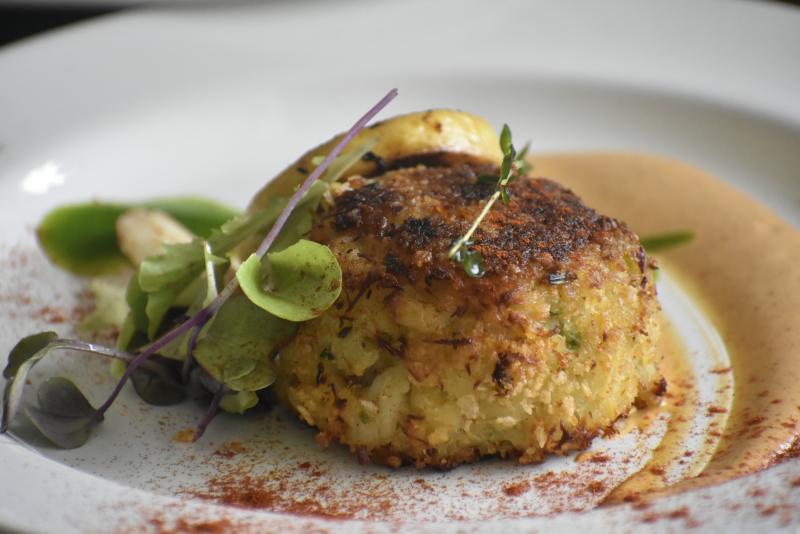The family-owned accessories label Aranaz got so many requests for its crab bag, a wicker handbag in the shape of the crustacean, after it sold out, that the brand decided to reissue it. This was unusual, because Aranaz usually doesn’t bring back bags from its seasonal collections. Even more unusual was that these requests were coming during the pandemic, when the Filipino women asking for the wicker crab minaudieres — the term for a small substitute for an evening bag — didn’t really have anywhere to parade them.
The crab bag comes from Aranaz’s 2019 spring/summer collection, the theme of which was “tiki seashell,” drawing inspiration from items that would be found on a seashore. Co-founder and designer Amina Aranaz Alunan included artificial shells made out of resin in blue, pink, and black hues. There was a lot of fringe, too, drawing upon a Hawaiian influence.
“In a way,” Aranaz Alunan said, “this crab bag was one of our first pieces that was really quirky.” She was thinking about producing it as a clutch, something to be taken to a seaside wedding or an island holiday — just large enough to fit a cellphone, lipstick, and some cash or a credit card. “I did not want to design something that was too overpowering,” she said. Even though many Filipinos haven’t been going out much in the past year, she has seen her customers posting the bag as a piece of décor at home, in addition to being taken out on the intermittent night out. “We aim for [our pieces] to be an escape in your hand,” the designer said.
Aranaz Alunan’s family owns the factory that produces the brand’s accessories. It made, and still makes, accessories for international brands, but Aranaz Alunan wanted to start something of her own — accessories not only made in the Philippines, but also carrying a Filipino label. She was already selling a few pieces at Christmas bazaars to other Filipino society women while she was at college, and started building Aranaz in earnest after finishing a master’s in accessories design at Istituto Marangoni in Italy.

The quest to make quintessentially Filipino products has meant the brand’s raw materials are sourced from local farmers. Wicker is a favorite as it’s pliable and absorbs color well. Each region’s straw has varying degrees of absorption, so Aranaz bags are often made of materials grown from two or three regions. As the Aranaz factories’ orders are many farmers’ main livelihoods, they “really push to use these materials.” Sometimes, the farmers will call to ask if Aranaz needs their materials — the brand rotates sources — and the designers will look to see if there’s something they can incorporate into their products, participating organically in the local economy.
“It’s quite a long assembly line,” Aranaz Alunan said. She explained that farmers’ delivery dates are more suggestions than concretely reliable — she adds an extra month of buffer when ordering materials. Even with having weavers in-house, this wait for materials means she can’t deliver bags in the 30 or 60 days many international outlets would request. Still, her bags are stocked by tony department stores including Bergdorf Goodman in New York, Lane Crawford in Hong Kong, and Browns, Harrods, Harvey Nichols and Selfridges in London.
Aranaz only produces one season for its international market — the spring/summer — but also makes a holiday collection for the domestic market, near the end of the year, to bring in new inventory. The peculiarity of the Filipino market means that they don’t have to worry about bags not selling through immediately: “We could still sell bags at full price — even styles from two seasons ago — and women would buy them,” Aranaz Alunan said. The global fashion community has lately been talking about the viability of “see now, buy now” models, rather than showing clothes on the runway that would only be available for purchase six months later, but that’s how Aranaz has always functioned.
Reproducing Aranaz’s classic styles is easy because of its vertical integration; they produce hundreds or even thousands of some iterations. For quirkier styles, which make up around 10 to 20 percent of each collection, like the crab bag, Aranaz only makes a few — around 30 for the domestic market, plus however many their international clients ordered. They are also harder to make: For the crab bag reissue, Aranaz needed a new supplier to make the tubular wire frame (which forms the “skeleton” of the bag, around which the wicker is wound) as their initial one didn’t want to produce any more of the frames. Regardless, its appeal is clear — so much so, Kate Spade recently released its own, very similar, wicker crab minaudiere. Imitation is a form of flattery, after all.
The Link LonkMay 05, 2021 at 09:00PM
https://ift.tt/3nNTaON
How the Filipino Brand Aranaz Designed Its Iconic Crab Handbag - ARTnews
https://ift.tt/2MkGRbk
Crab


No comments:
Post a Comment